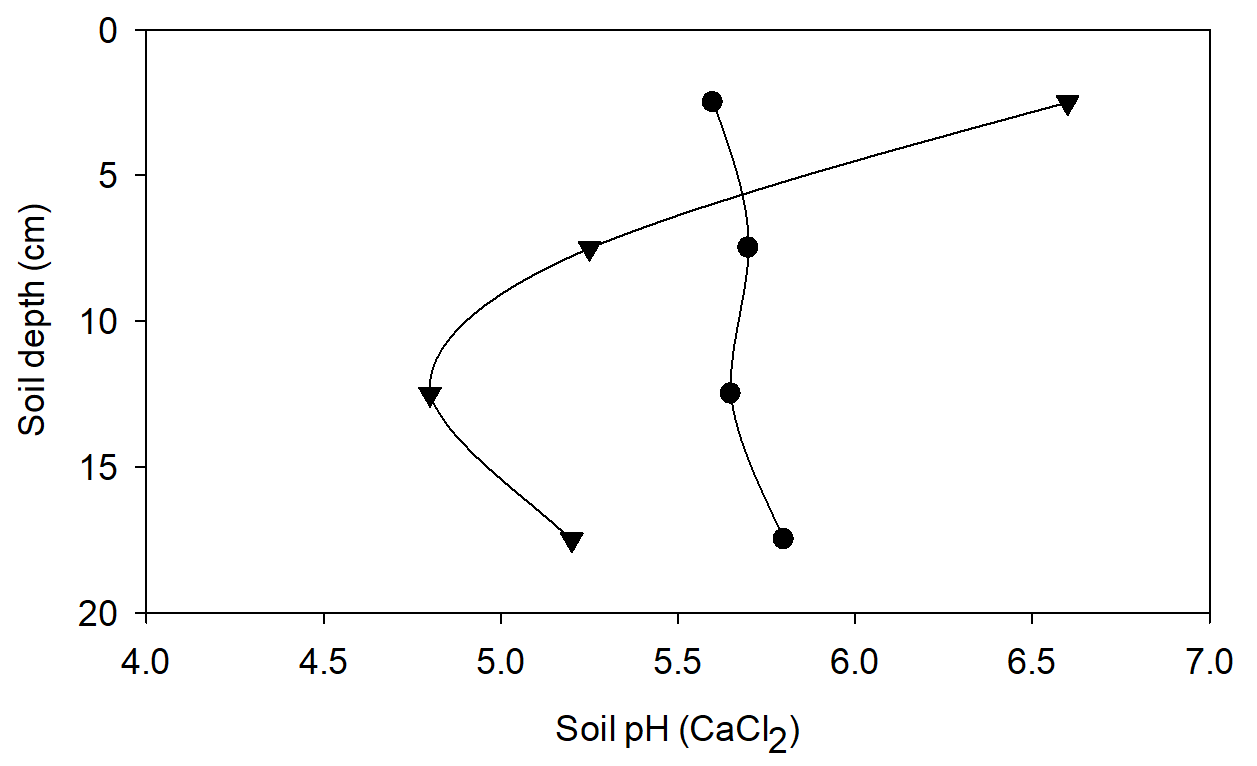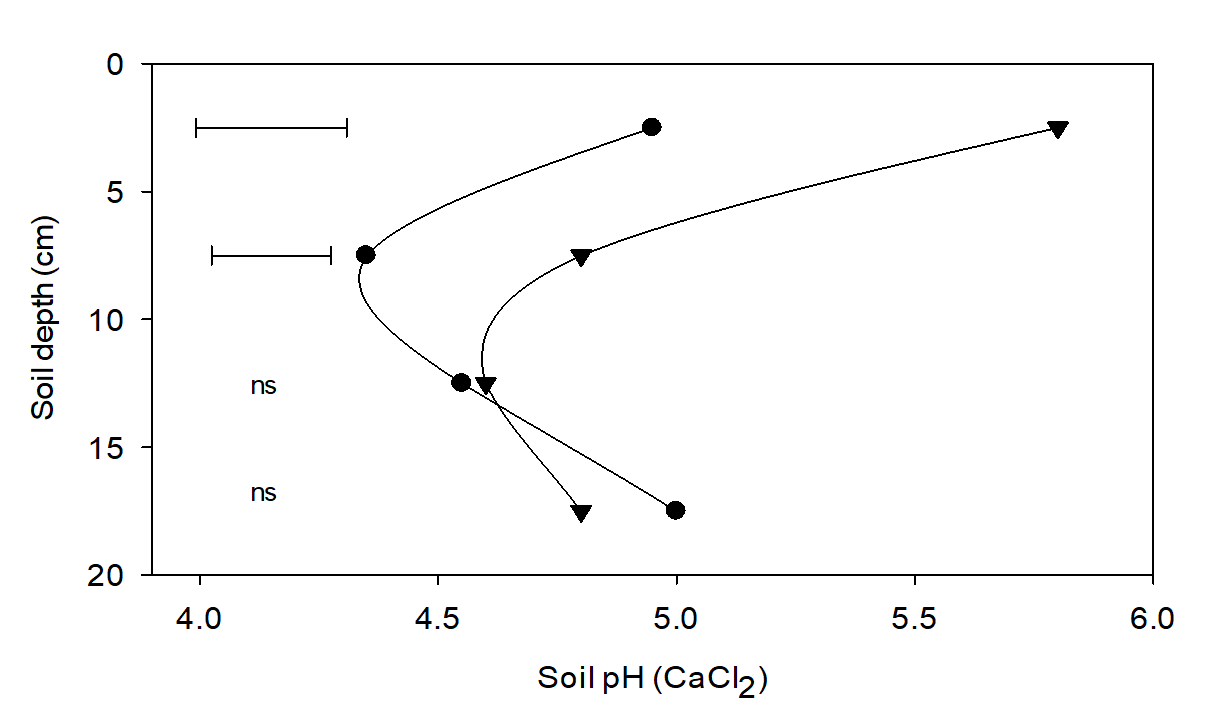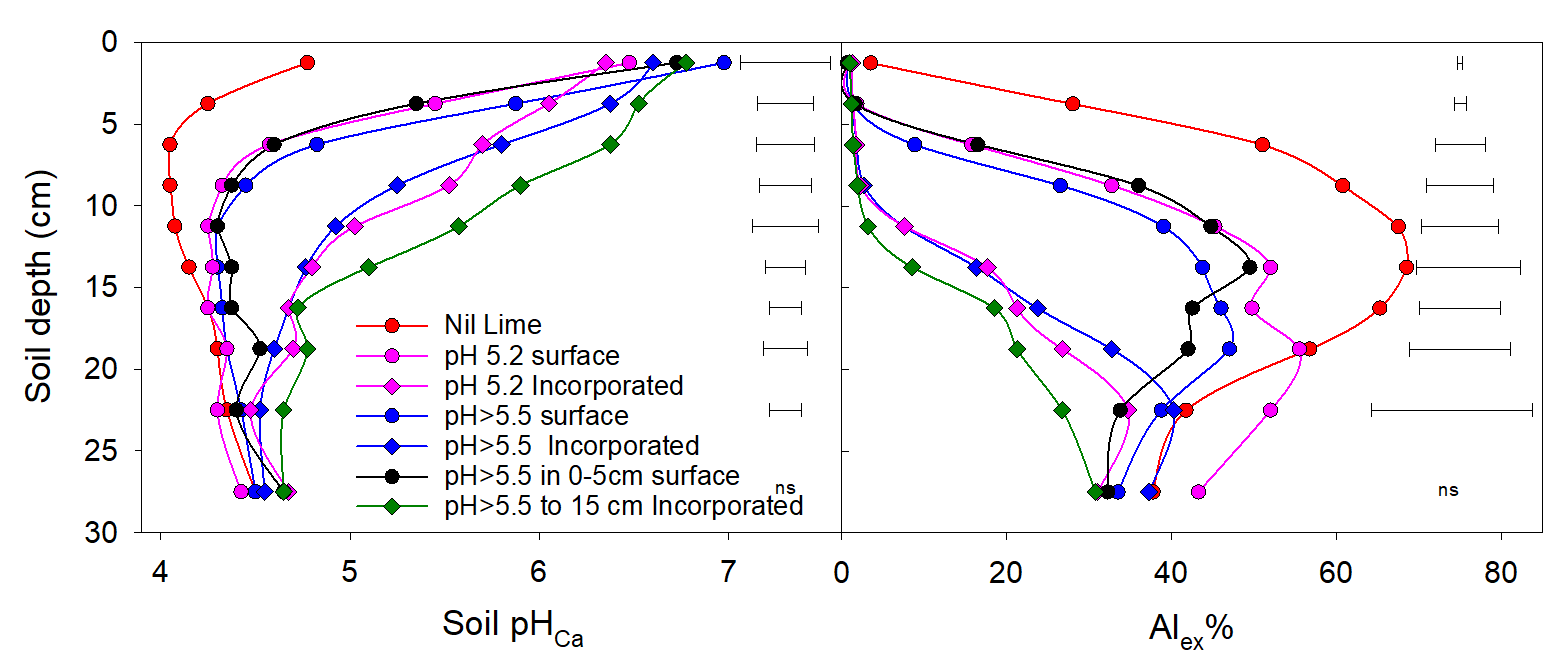Soil acidity - its stratification and amelioration with lime
Soil acidity - its stratification and amelioration with lime
Author: Jason Condon (Charles Sturt University & NSW DPI), Helen Burns (NSW DPI), Anne-Maree Farley (NSW DPI) | Date: 02 Aug 2022
Take home message
- Historic liming practices are ineffective in addressing the acidification of current farming systems
- Liming to pH targets greater than pH 5.5 and reliming when pH drops back to pH 5.5 maximises the downward movement of the liming effect to address subsurface acidity
- Deep incorporation to a depth of 20 cm was effective in ameliorating soil acidity to a depth of 15 cm
- Sufficient lime needs to be applied to ameliorate acidity within the depth of incorporation to warrant the risks and costs of deep incorporation.
Introduction
Soil acidity is an acknowledged constraint of agricultural production in south-east Australia. To date, research over the last 30-40 years has provided sound knowledge regarding processes associated with soil acidity. This has resulted in lime being applied by growers looking to maintain soil health, sustain productivity and maximise crop and pasture options available to them. However, ‘rules of thumb’ relating to the triggers to initiate liming, the rates of lime applied, and the frequency of applications are grounded to farming practices, production levels, and land and commodity prices of the 1990s.
Using these rules of thumb under current farming practices of no-till farming, high productivity per hectare (including from dual purpose crops), often driven by substantial applications of urea and ammonium-based fertilisers, have been shown to be ineffective in removing acidity from the soil and preventing soil pH decline in the subsurface layers. Figure 1 represents the soil pH profile of the surface 20 cm of an agricultural soil managed using traditional practices of lime application (2.5 t/ha every 8-10 years) compared to an adjacent site that had never been farmed. The lime application has failed to address the acidity formed below the 0-7 cm surface layer.
Stratification
Processes that change soil pH do not occur uniformly within agricultural soil profiles. They occur within different layers of the soil, often only several centimetres thick and as such, result in stratified soil pH profiles having higher pH in the surface few centimetres, due to lime application and return of crop residues, and relatively lower soil pH in the 5-15 cm region due to nitrogen transformations and acid excretion by plants due to nutrient uptake (Figure 1). These lower pH layers are called acidic subsurface layers and have been shown to have significant impacts on plant and soil biological function. This is especially important considering the depth of seed and fertiliser placement when sowing crops and pastures. We are often placing seeds within layers of soil with chemical conditions that are hostile to seedling germination and development of young roots.
Though important, the presence of acidic subsurface layers is often not identified by land managers/advisors due to the standard practice of soil sampling in 10 cm depth intervals. Standard 0-10 cm samples mask the presence of the severe acidity that can be present because the soil layer containing the very low pH is mixed in the sample; the 0-10 cm sample provides an average of the soil pH in that layer. For soils common to south-eastern Australia, it has been shown that sampling in 5 cm depth increments to a depth of 20 cm is an effective method to identify both the location and magnitude of acidity within the surface 20 cm of soil profiles (Condon et al. 2020).
Figure 1. Soil pHCa profiles taken from the field 40 m apart on the same soil type. Soil pH stratification following approximately 90 years of agriculture (▼) including three applications of lime using traditional practices (2.5 t/ha), compared to under native grass with no agricultural productivity (cemetery,●), north of Canowindra, NSW.
Amelioration
The lime use recommendations of the 1990s have been found inadequate in modern agriculture, which is more productive, has N fertiliser inputs and is based on no-till cropping systems that do not mix lime and soil together. The consequence of these changes is the formation of acidic subsurface layers, even where there has been a history of lime application (Figure 2) that are not detected by 0-10 cm soil sampling. The pH stratified profiles shown in Figure 2, have 0-10 cm soil test values of pH 4.6 and 5.3, yet both have layers of greater acidity than reported in the soil test. It is worth noting that the latter may result in a grower reporting no response to lime as the soil test value (0-10 cm) indicates lime has been effective, yet the acidic subsurface layer remains to limit plant performance. It is recommended that sampling depth increments of 5 cm be used to a depth of 20 cm to identify the presence, location and severity of acid subsurface layers.
Figure 2. Soil pHCa stratification following lime application within 5 years (▼,n =33) or more than 5 years (●,n=15) of sampling from locations between Albury and Cowra, NSW. Horizontal bars represent LSD (P=0.05), ns = no significant difference. (Adapted from Burns and Norton 2018).
The recommended liming practices generated from research of the 1980s and 1990s aimed to bring the pH to just over 5, to facilitate the minimal quantity of lime required to decrease the plant available aluminium (Al3+) concentration to less than that toxic to plants. This, in combination with higher rates of acidification and lack of soil mixing, results in the alkali of added lime being consumed within the soil surface thereby having no impact on acidity below 10 cm.
Though methods to address subsurface acidity are still being tested, the two simplest approaches are to incorporate lime to the depth of the acidity or apply lime at or near the surface and allow the alkali to move down with time. Long term field trials have demonstrated that maintaining soil at greater than pH 5.5 facilitates the downward movement of alkali from lime (Conyers and Scott 1989 and Li et al. 2019). Shifting to a liming target of greater than 5.5 with a re-liming trigger of pH 5.5 theoretically provides the best long-term outcome for soil pH and associated soil function. The authors have implemented a series of trials that test this under a range of agricultural enterprises, soil type, and rainfall zones. Whilst the higher pH target invokes a concern of greater costs to ameliorate to that level, it is worth remembering that as pH is logarithmic, it takes less lime to move from pH 5 to pH 5.6 than it does to move from 4 to pH 4.6. Therefore, it is cost effective to maintain pH before the acidity drops to a level that causes production losses.
Traditional liming practice applies lime at a rate to ameliorate soil in the 0-10 cm layer and incorporation is known to increase the effectiveness of application due to improved soil to lime contact and mixing through the depth of incorporation. Machinery is now commercially available that can rip and mix soil to a depth of 25 cm. The effectiveness of such machinery to incorporate lime required field experimentation. If the depth of incorporation increases beyond the traditional depth of 10 cm, the rate of lime applied needs to be adjusted to account for the greater soil volume to be ameliorated. Failing to do this will see the lime applied being diluted, resulting in smaller pH changes to the depth of incorporation than expected.
However, not all growers are interested in incorporating lime. Some growers are reluctant to incorporate in their no-till systems, while others may have substantial erosion risk due to slope of land or may be applying lime to existing permanent pastures where cultivation is not appropriate. Under these circumstances, surface application may be the only practical method of lime application. However, surface application will result in much of the applied lime sitting in the surface few centimetres, a depth region that exhibits higher pH than the underlying layers. As lime is sparingly soluble, it requires acid to dissolve, thus surface application to an already relatively high pH soil layer may result in lime sitting unreacted on the soil surface; a source of inefficiency of input dollars. It therefore makes sense that when applying rates of lime calculated to result in higher pH targets (pH >5.5), much of the lime may remain unreacted if surface applied and not incorporated. Greater efficiency of lime applied may occur if small but regular additions of lime are made; topping up surface applied lime as it dissolves. Though costs associated with spreading will be increased, the soil chemical and agronomic benefit of the practice needs to be examined under experimental conditions.
Field trial
A long-term experiment, with short term funding from a National Landcare Program project obtained with support of the Grasslands Society of NSW, was established at Lyndhurst NSW in 2020. The soil is a Red Chromosol (duplex) fine sandy loam with pHCa ranging from 4.6 in the surface to 4.2 at 20 cm. Exchangeable aluminium percentages were greater than 60% in some layers.
The following treatments were applied in March 2020.
- Control – untreated soil
- pH 5.2 surface – lime applied to the surface at rate of 4.7 t/ha which theoretically would raise the pH of the 0-10 cm to pH 5.2. To be surface relimed once pH drops to below pH 4.8 in the 0-10 cm layer; representing historic liming practice.
- pH 5.2 incorporated – as above but with deep incorporation to a depth of 20cm.
- pH >5.5 surface – lime applied to the surface at a rate of 5.9 t/ha which should raise the soil pH of the 0-10 cm to pH 5.9. To be surface relimed once pH 0-10 cm equals pH 5.5.
- pH>5.5 incorporated – as above but with deep incorporation to a depth of 20cm.
- pH>5.5 in 0-5 cm surface - lime applied to the surface at a rate of 2.8 t/ha which should raise only the soil pH of the 0-5 cm to pH 5.9. To be surface relimed once pH 0-5 cm equals pH 5.5.
- pH>5.5 in 0-15 cm incorporated- lime applied to the surface at a rate of 7 t/ha which should raise the soil pH of the 0-15 cm to pH 5.9 followed by deep incorporation to a depth of 20cm. To be surface relimed once pH 0-10 cm equals pH 5.5.
Superfine, high neutralising value (>98%) lime was applied. Deep incorporation to 20 cm was done using a Horsch® Tiger cultivator. The trial was sown to dual purpose wheat in 2020 and resown to phalaris, arrow and subterranean clover pasture in 2021. The soil from experimental plots were sampled in 2022 and soil pH and exchangeable aluminium percentage (percentage of the cation exchange capacity occupied by Al3+) is shown in Figure 3.
Figure 3. Soil pHCa profiles (left) and exchangeable aluminium percentage (right) sampled in 2022, two years after lime application at treatment rates to achieve targeted soil pH shown in legend. Lime was either surface applied or deep incorporated on a duplex fine sandy loam at Lyndhurst, NSW. Horizontal bars represent LSD (P=0.05), ns = no significant difference.
Surface applications, which by necessity were incorporated by sowing, increased soil pH relative to the control to a depth of 5 cm. However, the Al% remained greater than 40 % below 10 cm for those treatments. The soil pH and Al% of treatments receiving surface applied lime were relatively similar, although the pH of the pH>5.5 surface was significantly greater than the pH 5.2 surface treatments in the 0- 5 cm soil layers. No significant difference in Al% existed between surface applied treatments.
When lime was incorporated to depth, significantly greater soil pH occurred in layers to a depth of 17.5 cm compared to the matching lime treatment when surface applied. There was no significant difference in soil pH for pH 5.2 and pH>5.5 treatments when incorporated. When lime was applied at a rate to ameliorate to 15 cm (7 t/ha), soil pH was significantly greater than all other treatments in the 5-15 cm layers.
The incorporation of lime at all rates examined effectively removed Al3+ from solution to a depth of 10 cm (Figure 3) and decreased Al% to less than 30% to a depth of 15 cm. Significant decrease in Al% relative to the control were observed to a depth of 20 cm when lime was incorporated.
Conclusion
In the two years of the experiment, surface application of lime without incorporation has had minor effect below 5 cm, with little difference between rates. This may be due to the elevated surface pH resulting in much of the applied lime remaining unreacted at the surface.
The Horsch Tiger was effective in ameliorating soil acidity to a depth of 15 cm, with improvements in soil chemical measures to 20 cm depth, relative to the control. However, such cultivation is not without peril. The soft cultivated soil is unsuited to grazing before root mats have formed. The porous soil structure created, may lead to a seed bed too wet to be trafficked for sowing or herbicide application after soaking rainfall. Though effective in rapid amelioration of acidity, optimisation of post cultivation management requires thought prior to implementing deep cultivation to incorporate lime within farming rotations. Given these issues, the data indicates that applying lime at a rate to ameliorate the acidity present within the depth of incorporation results in the greatest reward, in terms of pH increase, for the risk and costs associated with deep cultivation.
Acknowledgements
The research presented was possible with the financial support of NSW DPI and the National Landcare Program in collaboration with Central West Farming Systems, FarmLink, Holbrook Landcare Network, ACT NRM, and the Grasslands Society of NSW. The authors especially thank the many producers hosting trial sites and that have contributed to the direction of the research.
Contact details
Dr Jason Condon
NSW DPI and Charles Sturt University
Locked bag 588, Wagga Wagga NSW 2678
Ph: 02 6933 2278
Email: jcondon@csu.edu.au
® Registered Trademark



